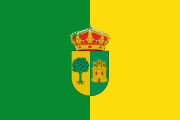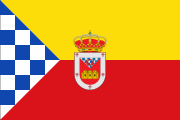


5. Trip through Extremadura
5. Viaje por Extremadura
October 1 to 4, 2021
Day 2 Montánchez to Trujillo
October 2, 2021



82. Montánchez
82. Montánchez


The first point to visit in the morning is the town of Montánchez. This town is important because the order of Santiago settled in the place after the reconquest. The only town in Extremadura where this order was. From the castle, which was of Roman origin, many incursions were made against the Arabs, ending up recovering all the territory of present-day Extremadura.
From the reconquest until the middle of the 17th century, the castle would function as a residence for noble people and as a prison.
Today the castle of Montánchez can be fully visited and is located at the top of the town. Inside the castle it is planned to enable the keep to make a museum and provide income to the town, because there is currently no gate in the enclosure and visiting it is free.



The town is quite common to other towns in the area, with a church, that of San Mateo quite old, originally from the 14th century but fully restored almost in the 18th century.




83. Alcuéscar
83. Alcuéscar
The second town,
Alcuéscar, is somewhat larger than the previous one. However, centuries ago, Montánchez was the head of the region and the order of Santiago had a small headquarters in this town.
The town gained importance from the 16th century and in it there are several houses of great families as noble houses.



As religious buildings there is the church of the Assumption, from the 15th century and completed in the 17th century. When I went there was the feast of the Virgin and they had her decked out in typical Extremaduran costume. It has 7 hermitages and a Plaza Mayor that has nothing special. It is larger than the one in Montánchez and is Gothic and Baroque in style.



But what stands out the most is for having the
Church of Santa Lucía del Trampal just 3 kilometers from the town. One of the few churches in all of Spain still standing from the Visigothic period. It is a mix between Visigothic and Mozarabic and because it was hidden in the undergrowth for centuries, it has been preserved in very good condition. It was discovered by a plunderer who was looking for remains from the French War of Independence and came across this construction. Then, before the town was notified, the entire area would be cleaned and the first archaeological works carried out. All the remains of this church are in the archaeological museum of Cáceres. Although they have built a building to accommodate a guard and make an explanation of the building as well as a visual projection.






84. Valdefuentes
84. Valdefuentes
After seeing these two towns, I would see
Valdefuentes, very close to the hotel where I was staying, which is barely 30 km from Cáceres. This town has a very wide square and a couple of churches.
The church of Nuestra Señora de la Virgen de Bienvenida is from the 17th century, Baroque in style and very large. In the photo.


It also has
a convent, that of San Agustín, in which the Sande family would make a burial vault for their family. The church of the convent is from the 18th century and has a cloister inside.


What really stands out is
the Sande palace which has two floors, the ground floor opens into an arched portico (currently solid) and the upper floor has an architrave gallery with graceful Renaissance columns. In the square the decorated jurisdictional roll because I was on the day of the Virgin.



85. Guadalupe
85. Guadalupe
In the afternoon, after eating, I went to see
Guadalupe or the town of Guadalupe.
This city is known worldwide for
its monastery and its Virgin, which although I had visited it when I was a child, I remembered practically nothing.


The image of the virgin is said to come from Palestine and was brought from there and placed in Seville by the pope at that time, but when the Moors invaded the peninsula, the Christians would hide it.
Evidence made on the carving that is said to have appeared to a shepherd at the end of the 13th century and a hermitage would be built in the place of the apparition where later Alfonso XI would order the construction of the monastery due to luck in the battles that according to him had been the work of the Virgin.
Visiting the church of the Royal Monastery of Santa María is free and admission costs 5 euros.
It is well worth going in as they show you rooms that are authentic cultural jewels, full of paintings and precious stones.
The most important parts are the 14th century Gothic church, with Baroque decoration.
The main altarpiece made in the seventeenth century, gold and polychrome with paintings by the son of El Greco.
The Camarín of the Virgin of the eighteenth century.



 The Mudejar cloister
The Mudejar cloister with two floors and a small Gothic Mudejar brick pavilion covered with Manises tiles.


The Chapterhouse from the 15th century with important Gothic frescoes.
The
Gothic cloister that was an old apothecary and hospital. The cloister is one of the largest in Spain, having a large garden and it is that this monastery came to house the lives of 400 friars.
The sacristy and chapel of San Jerónimo with paintings by Zurbarán.
The museums of painting and sculpture, with a treasure with embroidered frontals and a museum of large illuminated choir books.
And it is that Guadalupe for many years has been a place of pilgrimage to the virgin and gold and jewels have been donated from America.
The town is also quite homogeneous in its buildings, with a cobbled floor and streets with a multitude of historical arches. Among them
the church of the Holy Trinity, a building from the 18th century.
The Colegio de Infantes, an old religious teaching center from the 15th century.
Set of hospitals for pilgrims who came to the Monastery, and a series of medieval arches at the entrance doors of the great wall of which only a few pieces remain.




86. Trujillo
86. Trujillo
After seeing the monastery I would go to
Trujillo, one of the most beautiful towns with the most history in Cáceres and I would dare to say in all of Spain. Such is the density of monuments per square meter, mostly palaces and religious buildings, that she has been chosen along with Cáceres to film the mega-film production of Game of Thrones there and has been re-elected to shoot numerous scenes for the new series, the prequel to Game of Thrones, a series made up of 10 seasons, one of the longest.
The town was already important with the Arabs, having one of the largest fortifications in Extremadura after the citadel of Badajoz. But it would not be until the fifteenth and sixteenth centuries when the heyday of the city from the games that came from America would begin. The town is famous for being the hometown of one of the most famous Spanish conquistadors, Francisco Pizarro who led the conquest of almost all of South America, from Colombia to Peru. Many would follow him in the exploration and conquest of the New World and many from precisely the same city as him, where they filled the city with beautiful palaces and noble titles appointed by the Spanish Habsburgs.
I would park on Avenida Ramón y Cajal, one of the main arteries of the city. Near the
Convent of the Dominicans of La Encarnación, which dates from the end of the 16th century in the Gothic style and was built on another building.


Nearby is
the square of Juan Pizarro de Aragón and its palace. Today it functions as a cultural center and also the Orellana palace. Both were conquerors of the Americas in the 16th century.


Then you would pass by
the church of San Francisco, a former convent of San Francisco, one of the most important in the city. It dates from the 16th century and is in the Gothic style with the shields of the nobles who sponsored its construction.


Then you would arrive at
the Plaza Mayor, the nerve center of the city and the most popular point when talking about Trujillo. In it is the statue of the conquistador Francisco Pizarro, who has a large palace in the central square and which, together with
the statue on horseback, is one of the most photographed in Spain.

The square is surrounded by palaces since many of its men were from Trujillo and also the cradle of other conquerors.
The Palace of the Conquest the most visited, which has a large shield on the corner of the building and
the Palace of San Carlos. Both are from the 16th century, and were completed after their deaths. The style of its cover is baroque of the Churrigueresque type.





In the same square is the
Iglesia de San Martín, dating from the 14th century, it would undergo changes, going from the Gothic to the Renaissance style both on the outside and inside.
Continuing along the street on the way to the citadel, I found emblematic sites such as
the gate of blood, located between
the church of Santiago and the Casa Forte de Luis de Chaves, they are flanking very tall towers. This point is the scene of several scenes from the Game of Thrones series. In the right image, the facade of the church of Santiago.


Another of the buildings that I found, already getting dark, was the most important church in the city, which, being dark, does not show clear differences, but it is much bigger than the others.
This church is one of the first in the city, its construction beginning in the 13th century as soon as the city was reconquered from the Moors. In it you can see Romanesque influence but the predominant style is Gothic since it would be rebuilt in the 15th and 16th centuries.
The most important thing in the church is the Gothic-style altarpiece. It consists of a series of tables with Flemish-style paintings, a rarity in religious art in Extremadura.


The image of the two churches at night is spectacular.


Finally, I would visit
the castle of Trujillo, it is a fortress built between the 9th century and the 12th century in a town in Trujillo.
The castle is built with ashlar granite blocks and has several defensive square towers around it, two of which have a horseshoe arch and an image of the Virgen de la Victoria, patron saint of Trujillo. In the 15th century, a second walled enclosure or albacara was added. It also has a wall with battlements and doors, of which 17 rectangular towers remain.



From above the panoramic view is spectacular and at night also enveloping us in another time.


What is missing is the visits to the interiors of the palaces, and that most of the churches only open during liturgical hours and not for tourism, at least when I was there. I was only 3 hours but this town is well worth a whole day to visit it. Finally he would go to dinner at a well-known restaurant in the town.
Church of Santa Lucía del Trampal, s.VII-IX.
3
Main square and Marquis Palace, s.XVI
4
Royal Monastery of Guadalupe, s.XIV.
5
Main square and palaces, s.XVI.
6
Day 3, Cáceres in one day (CLICK to continue)
October 3, 2021






































































